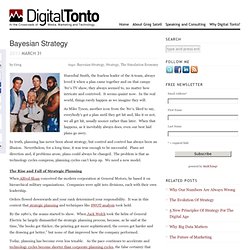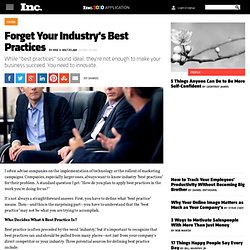

Don’t Sell a Product, Sell a Whole New Way of Thinking. We all know the story.

A team creates a groundbreaking new innovation only to see it mired in internal debates. When it is eventually launched in the market, there is an initial flurry of sales to early adopters, but then sales cycles become sluggish. Pilot customers are enthusiastic, but broader adoption is slow even with customer support and training. How to Do Business Model Innovation for the Established Firm. This article provides a systematic framework for helping executives of large, established organizations identify opportunities for business model innovation and organize themselves to pursue these opportunities.

Now - Michael Birshan, Martin Hirt , and Kurt Strovink. By Michael Birshan, Martin Hirt and Kurt Strovink | 12:00 PM November 20, 2013 Two uncomfortable strategic truths face the vast majority of executives and companies – and probably you, too.

First, you don’t have a powerful strategy. And second, you aren’t doing much about it. Though both statements may sound extreme, they are the clear implication of new McKinsey research on how companies create value and allocate resources. The widespread absence of a powerful strategy is clear from our recent study of 3,000 of the world’s largest companies, which finds that just 20 percent in that group create 90 percent of its total economic profit. Latest Gartner Hype Cycle. Evaluating technology options for innovation in marketing – do you know your hype cycles?

If you’re involved in marketing strategy development, you will be constantly making judgements and doubtless arguing with colleagues about which digital technology innovations are most relevant to your organisation. In this post we share some examples of Gartner’s well established Hype Cycle tools which serve to highlight the adoption of new technology tools within the marketplace. I’m noticing a lot more innovation roles in larger organisations recently. It’s great to see companies investing in understanding technology and marketing trends to try to create a roadmap for prioritising and implementing innovative digital technologies for marketing applications. The Gartner Hype Cycle model for technology innovation Gartner Hype Cycles for technology and marketing in 2013 In August 2013, Gartner followed with their Latest 2013 Hype Cycle of emerging technologies.
The strategic yardstick you can’t afford to ignore. From exponential technologies to exponential innovation. We developed the Shift Index to help executives understand and take advantage of the long-term forces of change shaping the US economy.

The Shift Index tracks 25 metrics across more than 40 years. These metrics fall into three areas: 1) the developments in the technological and political foundations underlying market changes, 2) the flows of capital, information, and talent changing the business landscape, and 3) the impacts of these changes on competition, volatility, and performance across industries. Combined, these factors reflect what we call the Big Shift in the global business environment. The Evolution Of Strategy. Our Self-Inflicted Complexity - Roger Martin. By Roger Martin | 8:00 AM September 6, 2013.

Work Is Broken; Let's Hack It. A Technique for Producing Ideas. The Golden Age Of Management Is Now. Companies Fall, Entrepreneurship Rises. By Daniel Isenberg | 12:30 PM March 18, 2013 When a whale dies, the 30-100 ton body — or “whale fall” — slowly, silently sinks to the ocean bottom where it becomes the wellspring of a complex new microcosm of seabed flora and fauna that can thrive for well over half a century.

Become & Stay Great. Disrupt or Be Disrupted. Bayesian Strategy. Hannibal Smith, the fearless leader of the A-team, always loved it when a plan came together and on that campy ’80′s TV show, they always seemed to, no matter how intricate and contrived.

Bayes’ Rule Makes A Better Thinker. Success Makes Big Companies Stupid. Our Numbers Are Always Wrong. Our data driven society requires hard numbers.

Forget Industry Best Practices. I often advise companies on the implementation of technology or the rollout of marketing campaigns.

Companies, especially larger ones, always want to know industry "best practices" for their problem. There Are No Best Practices. Strategic Partners. Set Business Goals. Corporate Strategy & Operations. During countless conversations we have with executives, they discuss the biggest strategic planning challenge they face within their environments – that of strategy execution. Aligning corporate strategy to operational execution is indeed critical, yet most organizations fail to continue the planning effort beyond the corporate planning process – into the operational layers of the organization. By doing a good job in this area, organizations can establish the necessary links from strategic goals to the business-level execution of strategy-supporting initiatives.
Those links and the governance to manage overall progress at a plan-level constitute the “golden thread” required to sew corporate strategy together with operations so that strategies can be implemented successfully. How do we string the “golden thread”? All organizations are in need the golden thread that links strategy to execution initiatives and operational planning is the answer. Fewer Customers, Faster Growth. Navigate Tough Prospects. The "True Value Test" By David Tager | 12:00 PM April 16, 2013. Strategic & Corporate Five. Where to Play and How to Win.
Relevant Core Competencies. Strategy Is All About Practice. By Roger Martin | 1:00 PM February 20, 2013 I have never seen anybody become good at strategy without practice. Building A Fast-Growing Business. 4 Things for Successful Business. Starting a new business is hard. 8 Timeless Business Principles. Top 10 Influential Business Books. 4 Keys for Strategic Thinkers.